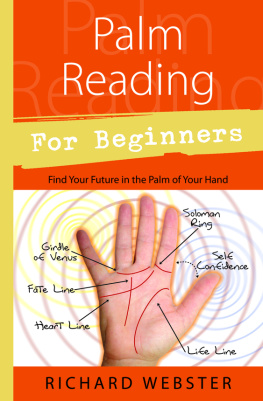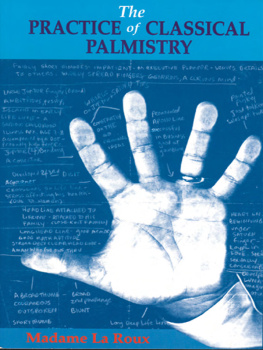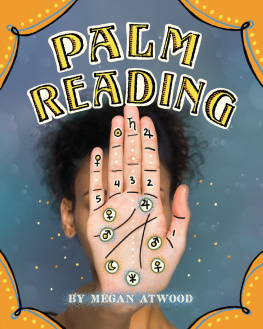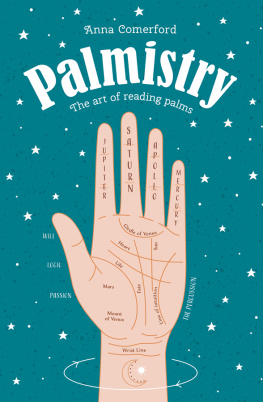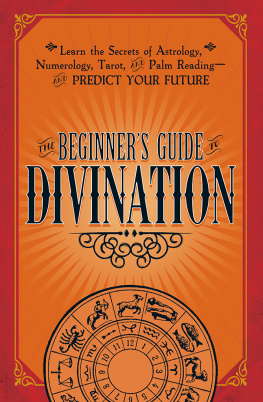About the Author
Richard Webster was born in Auckland, New Zealand in 1946. New Zealand is still his home, though he travels widely every year lecturing and conducting workshops on psychic subjects around the world. He is a prolific author and also writes monthly columns for two magazines. Richard began his working life in publishing, and became in turn a bookstore proprietor, pianist, stage hypnotist, palmist, ghostwriter, and magician before becoming a professional teacher and writer on psychic topics.
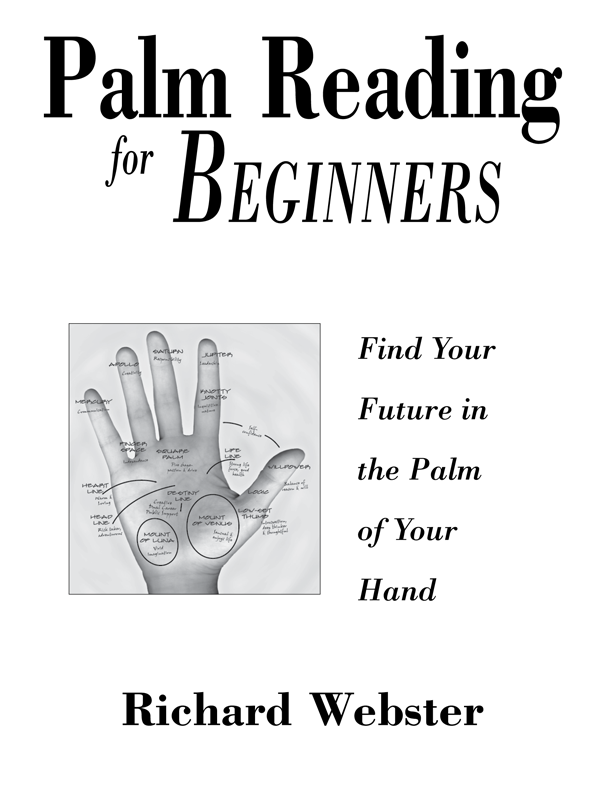
Llewellyn Publications
Woodbury, Minnesota
Copyright Information
Palm Reading for Beginners: Find Your Future in the Palm of Your Hand 2000 by Richard Webster.
All rights reserved. No part of this book may be used or reproduced in any matter whatsoever, including Internet usage, without written permission from Llewellyn Publications, except in the form of brief quotations embodied in critical articles and reviews.
As the purchaser of this e-book, you are granted the non-exclusive, non-transferable right to access and read the text of this e-book on screen. The text may not be otherwise reproduced, transmitted, downloaded, or recorded on any other storage device in any form or by any means.
Any unauthorized usage of the text without express written permission of the publisher is a violation of the authors copyright and is illegal and punishable by law.
First e-book edition 2012
E-book ISBN: 9780738718040
Cover design and photo: Adrienne W. Zimiga
Cover model: Jeanette Jones
Interior illustrations: Jeannie Ferguson
Editing and interior design: Eila Savela
Llewellyn Publications is an imprint of Llewellyn Worldwide Ltd.
Llewellyn Publications does not participate in, endorse, or have any authority or responsibility concerning private business arrangements between our authors and the public.
Any Internet references contained in this work are current at publication time, but the publisher cannot guarantee that a specific reference will continue or be maintained. Please refer to the publishers website for links to current author websites.
Llewellyn Publications
Llewellyn Worldwide Ltd.
2143 Wooddale Drive
Woodbury, MN 55125
www.llewellyn.com
Manufactured in the United States of America
For my good friend Carl Herron,
gifted psychic, humorist, philosopher,
and publisher of The Path
Table of Contents
The Whole Hand
The Major Lines
Timing on the Hand
Minor Lines
The Fingers
The Mounts
The Quadrangle
Marks on the Hand
Skin Ridge Patterns
Health, Wealth, Love, and Happiness
Putting It All Together
Making Palm Prints
Conclusion
Illustrations
Introduction
Palmistry is one of the oldest of the occult arts. People have been fascinated with hands since time began. There are imprints of palms in the innermost parts of the Santander Caves in Spain, showing how important hands were to people in Stone Age times.
The most important moment in human evolution occurred when man began to stand upright. This meant that the hands, which up until then had been used as front feet, were now able to be used for other purposes. In fact, they became an extension of the human mind. More room is taken up in the brain for the different activities of our hands than for any other organ of the body. It is fascinating to watch newborn babies interact with the world using their hands. Even something as simple as touch has to be learned.
The brain sends messages to the hands, instructing them to perform any number of intricate tasks. Many of these tasks have had to be learned in the first place, but become automatic as soon as they are mastered. Writing with a pen is a good example of this. The hands also send information to the brain. If you have ever touched something hot, you know exactly how quickly that information is sent to the brain.
At some stage people realized that every hand is different, and from this discovery palmistry began. The fact that no two hands are the same must have intrigued primitive people. One explanation for this can be found in the Bible: He sealeth up the hand of every man, that all men may know His work (Job 37:7).
Primitive man was also able to make practical use of this information. Thumbprints and fingerprints were used instead of signatures. In China there are numerous examples of important papers that have been signed with the thumbprint of the emperor.
Some 2,600 years ago Aristotle wrote a book on palmistry for Alexander the Great, and there is nothing in that book that a modern-day palmist would dispute. Consequently, the basic principles of palmistry have been around for a long time.
Palmistry has had an extremely varied history. At times it has been revered, while at other periods it was considered the work of the devil. Unfortunately, different superstitions were added to palmistry over the years, and these caused many people to discredit the subject without evaluating it further.
Palmistry was first treated in a scientific manner in France during the nineteenth century. A man called Adolphe Desbarrolles investigated palmistry with the intention of disproving it. However, his research convinced him of the validity of the subject, and eventually he wrote a monumental book on palmistry.
At about the same time, a retired army officer called Stanislas dArpentigny discovered a remarkable fact. He had become friendly with a couple who entertained on a regular basis. DArpentigny found that most of the guests at the parties arranged by the husband had short, blunt hands with stubby fingers. The guests invited to the wifes soirees had hands that were shapely, slender, and had long fingers.
DArpentigny began studying palmistry and developed a system of hand classification that is still used by many palmists today. He also wrote a book on the subject.
In 1900 William Benham, an American, published his monumental book The Laws of Scientific Handreading . In this book he explained how to read palms scientifically. Up until then, most people believed that you had to be psychic in order to read palms.
Since then, a number of people have followed in his footsteps. Psychologists became interested in how accurate palmistry is in revealing character, and many books have been written from a psychological point of view. The first of these was published in 1848 by Dr. Carl Gustav Carus, who was the personal physician to the king of Saxony. His book ( Die Symbolik der Menschlichen Gestalt und Ueber Grund und Bedeutung der Verschiedenen Formen der Hand ) related the fingers of the hand to the persons conscious mind, and the palm to the subconscious.
Since the end of World War II, the Kennedy-Galton Center, attached to the University of London, has been studying palms scientifically, using them to determine the predisposition of people towards certain illnesses. Certainly, nothing could be more important than health, and it is exciting that modern-day scientists are proving scientifically what palmists have known for thousands of years.
By taking up palmistry you will be joining a tradition that has lasted for thousands of years.
I first became interested in the subject as a young boy. I used to regularly visit a neighbor who was an excellent cook. I was a keen reader and was fascinated to discover that she and her husband had a large library in their home. I would sit in their library for hours, eating her scones and cakes, and looking at the books on every wall.
One day I noticed a large section of books on palmistry. These belonged to her husband, who was a palmist. Palmistry was illegal in New Zealand at the time, and he used to give readings quietly and secretly. I think it amused him to find a small child showing interest in this subject, and he taught me some of the basics of palmistry. I would go to school and look at the palms of the other students, but did not take the subject seriously until I reached puberty and discovered what a wonderful way it was to meet girls!
Next page
